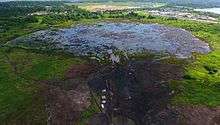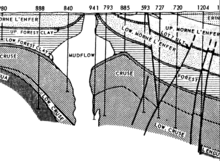Pitch Lake





The Pitch Lake is the largest natural deposit of asphalt in the world, estimated to contain 10 million tons. It is located in La Brea in southwest Trinidad, within the Siparia Regional Corporation. The lake covers about 100 acres and is reported to be 250 feet deep.[1]
Pitch Lake is a popular tourist attraction, that includes a small museum, from where official tourguides can show you the lake. The lake is mined for asphalt by Lake Asphalt of Trinidad and Tobago.
History
The Pitch Lake has fascinated Western explorers and scientists, as well as attracting tourists, since its re-discovery by Sir Walter Raleigh in his expedition there in 1595. (The native Indians knew about it and showed it to him.) Raleigh himself found immediate use for the asphalt to caulk his ship. He referred to the pitch as "most excellent... It melteth not with the sun as the pitch of Norway".[2] Since its re-discovery, there have been numerous research investigations into the use and chemical composition of this material. There have been countless theories, postulations, and conclusions as to the size, source, and origin of the asphalt.
In 1887, Amzi Barber, an American businessman known as "The Asphalt King", secured a 42-year monopoly concession from the British Government for the Pitch Lake for his company, Barber Asphalt Paving Co. It was from this source that many of the first asphalt roads of New York City, Washington D.C., and other Eastern U.S. cities were paved.[3]
It was the natives, the Amerindians, that showed Sir Walter Raleigh where the lake was. They were the ones who named the black substance piche, which over time became to be known as pitch. The natives had their own story about the origin of the lake. The story goes that the indigenous people were celebrating a victory over a rival tribe when they got carried away in their celebration. They proceeded to cook and eat the sacred hummingbird which they believed possessed the souls of their ancestors.[4] According to legend their winged God punished them by opening the earth and conjuring the pitch lake to swallow the entire village, and the lake became a permanent stain and a reminder of their sins. The local villages believe this legend due to the many Amerindian artifacts and a cranium that have been discovered, preserved, in the pitch.[5]
Microbiology
Evidence of an active microbiological ecosystem have been reported. The microbial diversity at Pitch Lake was found to be unique when compared to microbial communities analyzed at other hydrocarbon-rich environments, which included Rancho Le Brea, a natural asphalt environment in California, USA, and an oil well and a mud volcano in Trinidad and Tobago, among other sites.[6] Archaeal and bacterial communities co-exist, with novel species being discovered from Pitch Lake samples.[7] Besides this, novel fungal life forms are described which can grow on the available asphaltenes as a sole carbon and energy source.[8]
Geology
The origin of The Pitch Lake is related to deep faults in connection with subduction under the Caribbean Plate related to Barbados Arc. The lake has not been studied extensively, but it is believed that the lake is at the intersection of two faults, which allows oil from a deep deposit to be forced up.[9] The lighter elements in the oil evaporate under the hot tropical sun, leaving behind the heavier asphalt. Bacterial action on the asphalt at low pressures creates petroleum in asphalt. The researchers indicated that extremophiles inhabited the asphalt lake in populations ranging between 106 to 107 cells/gram.[7][10] The Pitch Lake is one of several natural asphalt lakes in the world. The La Brea Tar Pits (Los Angeles), McKittrick Tar Pits (McKittrick) and Carpinteria Tar Pits (Carpinteria) are all in the U.S. state of California. Lake Guanoco is in the Republic of Venezuela.
The regional geology of southern Trinidad consists of a trend of ridges, anticlines with shale diapiric cores, and sedimentary volcanoes. According to Woodside, "host muds and/or shales become over pressured and under compacted in relation to the surrounding sediments...mud or shale diapirs or mud volcanoes result because of the unstable semi-fluid nature of the methane-charged, undercompacted shales/muds." The mud volcanoes are aligned along east-northeast parallel trends. Woodside goes on to say, "The Asphalt Lake at Brighton represents a different kind of sedimentary volcanism in which gas and oil are acting on asphalt mixed with clay. This asphalt lake cuts across Miocene/Pliocene formations overlying a complicated thrust structure."[11]
The first wells were drilled into Pitch Lake oil seeps in 1866. Kerosene was distilled from the pitch in the lake from 1860 to 1865. The Guayaguayare No. 3 well was drilled in 1903, but the first commercial well was drilled at the west end of the lake in 1903. Oil was then discovered in Point Fortin-Perrylands area, and in 1911, the Tabaquite Field was discovered. The Forest Reserve Field was discovered in 1914 and the Penal Field in 1941. The first offshore well was drilled in 1954 at Soldado.[11]:1
See also
References
- ↑ "'The Pitch Lake'". National Museums Liverpool.
- ↑ La Brea, home of the pitch lake
- ↑ Daniel Smith Lamb, Historical, Biographical and Statistical Souvenir (Washington: Beresford: Howard University Medical Department, 1900), 86.
- ↑ "La Brea, Pitch Lake," UNESCO World Heritage Centre, August 2011, accessed September 28, 2018, https://whc.unesco.org/en/tentativelists/5645/.
- ↑ Brock, Fiona, Joanna Ostapkowicz, Alex C. Wiedenhoeft, and Ian D. Bull. "Radiocarbon Dating Wooden Carvings and Skeletal Remains from Pitch Lake, Trinidad." Radiocarbon 59, no. 05 (October 2017): 1447-461. Accessed September 26, 2018. doi:10.1017/rdc.2017.78.
- ↑ Dirk Schulze-Makuch et al., "Microbial Life in a Liquid Asphalt Desert," Astrobiology 11, no. 3 (2011): abstract, accessed September, 2018, doi:10.1089/ast.2010.0488.
- 1 2 Microbial (2011). "abstract". Astrobiology. 11: 241–258. arXiv:1004.2047. Bibcode:2011AsBio..11..241S. doi:10.1089/ast.2010.0488.
- ↑ First (2011). "abstract". Microbial Biotechnology. 4: 663–672. doi:10.1111/j.1751-7915.2011.00269.x.
- ↑ "A Gravity Investigation of the Pitch Lake Of Trinidad And Tobago". Geological Society of Trinidad & Tobago. Archived from the original on 2010-01-31. Retrieved 2008-05-27.
- ↑ Microbial Life Found in Hydrocarbon Lake. the physics arXiv blog 15 April 2010.
- 1 2 Woodside, P.R., The Petroleum Geology of Trinidad and Tobago, 1981, USGS Report 81-660, Washington: US Dept. of the Interior, pp. 10
External links
| Wikisource has original text related to this article: |
| Wikimedia Commons has media related to Pitch Lake, Island of Trinidad. |
- Trinidad's Pitch Lake, a pictorial by Richard Seaman.
- sciencenews.org article on life in the lake
Coordinates: 10°13′57″N 61°37′41″W / 10.23250°N 61.62806°W